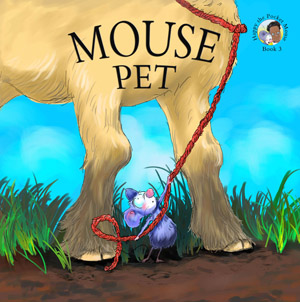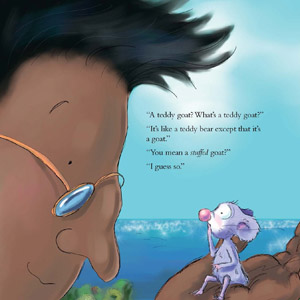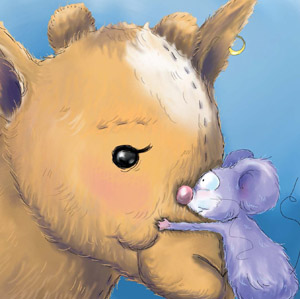| ________________
CM . . .
. Volume XXII Number 20. . . .January 29, 2016
excerpt:
Mouse Pet, the third in the “Happy the Pocket Mouse” series, is unique in that the story is told wholly through dialogue. As John and Happy walk through the park and to the store, they have a very funny conversation surrounding the pros and cons of having a pet, but with no other text to anchor the story, it could prove difficult as a read-aloud for a younger audience who may struggle to differentiate between speakers. Roy does mitigate this issue a bit by having the characters refer to each other by name often, but it doesn’t quite solve the issue. For children who can read aloud on their own, however, this is a very engaging way to share a bedtime story – the caregiver can read John’s lines while a child reads Happy’s part. Despite the format, which has pros and cons, the story is funny and imaginative as audiences will have come to expect from the imaginative little mo Funnier still are the illustrations. Balsara includes a few sight gags for the adult reader amongst the large, colour saturated cartoon images that hit the perfect note for the target age group. The most notable feature is how expressive Happy the mouse is. His emotions run the gamut from excited to depressed, and the attention to detail in his face is wonderful. Humour aside, Mouse Pet would do wonders to start a conversation with a child who really wants a pet. The story is light and fun, but it gets the point across that there’s more to owning a pet than simply playing with it. A parent could really engage a child by asking why Happy isn’t thinking his wish for a pet through completely and then considering what kinds of extra responsibilities exist. Because asking for a pet is a very common request among children, such a conversation would be a real bonus to this book. Recommended. Amber Allen is a librarian in Toronto, ON, with a passion for children’s literature and writing.
To comment on this title or this review, send mail to cm@umanitoba.ca.
Copyright © the Manitoba Library Association. Reproduction for personal use is permitted only if this copyright notice is maintained. Any
other reproduction is prohibited without permission.
CM Home |
Next Review |
Table of Contents for This Issue - January 29, 2016
| Back Issues | Search | CM Archive
| Profiles Archive |

 While taking a walk in the park, Happy the pocket mouse is struck with what he believes to be a great idea. He and John should get a pet! John is not so sure. While Happy insists that pet ownership is simple – amounting to no more than patting, feeding, and walking an animal you love – John is convinced it requires a lot more responsibility than that. The two friends discuss the prospect of welcoming an unusual pet into their lives, but they ultimately decide upon a compromise. Happy falls in love with a new stuffed pet from the toy store, and peace is restored in the relationship. For now.
While taking a walk in the park, Happy the pocket mouse is struck with what he believes to be a great idea. He and John should get a pet! John is not so sure. While Happy insists that pet ownership is simple – amounting to no more than patting, feeding, and walking an animal you love – John is convinced it requires a lot more responsibility than that. The two friends discuss the prospect of welcoming an unusual pet into their lives, but they ultimately decide upon a compromise. Happy falls in love with a new stuffed pet from the toy store, and peace is restored in the relationship. For now. use.
use.